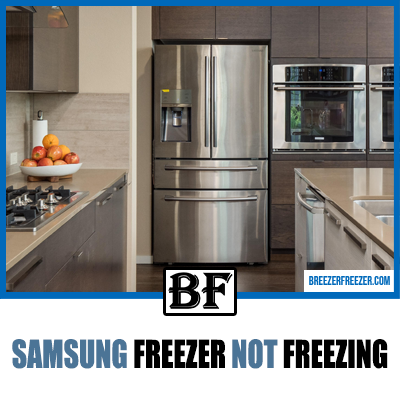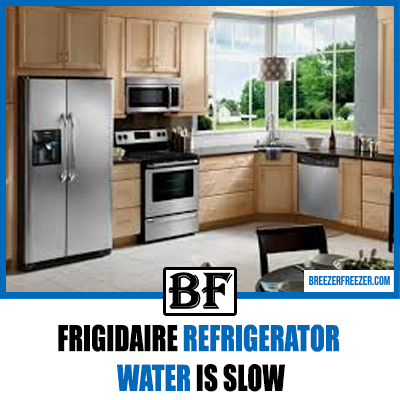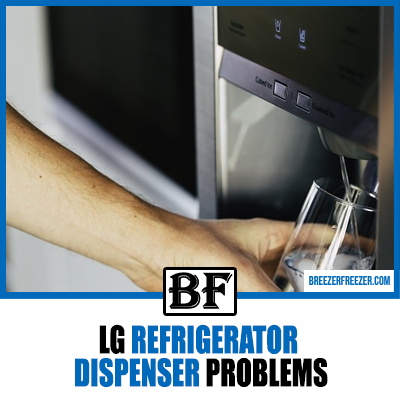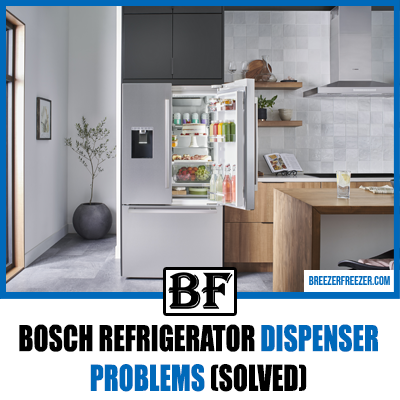Samsung Freezer Not Freezing
Just imagine, you are throwing a summer party at your place.

The invites have been sent, everything’s ready, but suddenly, you hear a strange sound from your fridge. It turns out your freezer has abruptly stopped freezing, and the ice is melting all over the place. What would you do?
If there’s still some time left, you need not worry about your Samsung freezer not freezing. We’ve got some easy tips up our sleeve to get your freezer up and running again.
So, without further ado, let’s dive into the details!
Why Is Your Samsung Freezer Not Freezing?
There are multiple reasons that can stop your Samsung freezer from working properly. Since there are several components in the freezer, the whole cabinet will suffer if even one of them stops functioning.
What To Check If Your Samsung Freezer Is Not Freezing?
Here is a list of freezer components that you can inspect when your Samsung freezer stops cooling despite being functional:
1. Evaporator Fan Motor
One of the most common reasons for freezer issues is evaporator fan malfunction. It draws in the air and maintains a steady circulation throughout the cabinet. If it is defective, the air won’t circulate, and the temperature of the freezer won’t stay as low as it should.
So, first and foremost, check the evaporator fan motor for winding continuity; it is typically found at the back of the fridge. It will need a replacement if there’s no continuity between the motor windings or if you hear mechanical noises.
2. Settings
Settings need to be on point for a Samsung freezer to work well, so you should try troubleshooting the appliance. Ensure that the temperature setting is on the coldest point, according to the service manual.
Now, changing freezer settings can be tricky as the parameters are different for a refrigerator with a manual dial and one with a digital control. The former usually has five numbers, the highest being the coldest and the lowest being the warmest. However, for the latter, the freezer gets warmer as the displayed number is increased.
It is also possible that the manual dial gets jammed and doesn’t turn freely. In that case, you’ll have to replace it.
3. Condenser Coils
Dirty condenser coils can also disrupt the cooling of the freezer, as the dust doesn’t allow adequate heat dissipation. Hence, it is crucial to keep them prim and proper.
Keep checking the coils at the back of the unit every now and then and routinely clean them with the soft brush head of the vacuum cleaner. Don’t forget to dust away the leftover dirt using a soft cloth. Repeat this every three to six months, and you’ll never come across condenser coil-related issues.
4. Frost
Over-frosting in the freezer is a menace and can considerably reduce its freezing capability. If you notice it on the cabinet walls, chances are, it has already infested the evaporator coils, and that will disturb the cold air circulation.
First of all, unscrew the inner rear panel to check if the evaporator coils have frosted. If yes, you’ll have to defrost the freezer manually, but if the fridge has an automatic defrost system, probably multiple components have malfunctioned. Therefore, it is best to leave the job in professional hands.
5. Compressor
Another important component worth inspecting is the compressor, as it is the primary cooling part of the freezer. If you can hear it buzzing, then it’s not responsible for the disrupted freezing, but if not, try unplugging and replugging the unit.
This simple step will most probably get the compressor running, but if that doesn’t happen, then it’s time to call a repair agent.
6. Air Circulation
A freezer will only be able to freeze if there’s an undisturbed airflow. And that won’t happen if anything obstructs the air vents, not allowing the fan from drawing in and pushing the air.
Moreover, the best way to facilitate a good flow of air is by organizing the freezer items and keeping the vents unblocked. If the freezing cabinet is overpacked, a cooling issue is bound to arise. So, make sure that you remove the draws and do a regular clean-up of the shelves and draws and dispose of unwanted stuff.
7. Seal
Lastly, the seal plays a key role in maintaining a cold atmosphere inside the freezer, but it is often overlooked by owners. The seal may wear off or start leaking, especially if the refrigerator is old.
To know for sure, tightly close the freezer door and keep your hand around it to feel any cold air seeping out. If you can’t sense anything, try the dollar trick to double-check the seal; open the freezer and close it while placing a bill on the door frame. Then, softly pull the dollar bill to get it out and if that happens effortlessly, consider replacing your film.
What To Do If The Top Half Of The Freezer Stops Working?
Freezer troubles come in different forms, and one of the peculiar ones is- the upper half stops freezing while the lower half works just fine. So, here are a few reasons that might be responsible for this situation:
1. The Air Filters Got Clogged
There are air filters in the freezer vents that regulate the airflow, and some of them will stop functioning on clogging with dirt. Over time, the air won’t be able to circulate in the cabinet, not allowing parts of it to work properly.
Hence, to prevent that, keep your air filters clean or replace them altogether if the situation gets out of hand. For that, you’ll have to single out the ones that have clogged and replace them accordingly.
2. The Evaporator Coils Froze
As we already discussed, frozen evaporator coils cannot eliminate the heat efficiently, turning it back to the gaseous state. Since they are present on the upper half of the freezer, they can stop cooling due to the backflow of the heat.
To deal with this, open the panel, thaw the frost on the coils and rid them of dust. This will get the whole freezer running again.
3. The Air Circulation Is Poor
As free airflow is necessary for the proper functioning of the freezer, the top half can stop working if the air cannot move in and out of it. At times it gets trapped in the bottom part and causes frosting, because of which the whole cabinet gets affected.
So, it’s crucial to keep the air circulation uniform by removing air filter blockages and keeping the freezer content organized.
4. The Evaporator Fan Broke
Often, frosting reaches the evaporator fan and jams it, or the motor fails due to overheating. This can lead to poor airflow, which in turn creates more trouble, which we just discussed.
To prevent this from happening, replace the evaporator fan motor as soon as it malfunctions or remove the frost from the fan blades.
What To Do If The Ice Maker Stops Working?
The ice maker of Samsung refrigerators can stop when the freezer stops cooling. Some of the factors that can affect this are:
1. Faulty Water Inlet Valve
When the water inlet is faulty, it doesn’t supply enough water to the ice maker, stopping it from dispensing enough ice. Additionally, low pressure lower than 20 psi hampers the water flow, affecting the performance of the ice maker. In this case, the inlet valve will have to be replaced with a new one.
But if both these factors seem on point and there’s sufficient water supply, consider replacing the ice makers.
2. Low Water pressure
Moving on, the water pressure depends on the water supply in your house, and if it’s low, the water flow to the ice maker is bound to take a hit. So, instead of fixing the freezer, you’ll have to contact a plumber and get your water supply fixed.
3. High Freezer Temperature
It’s no rocket science that ice only freezes at a low temperature, and if the ice maker is warmer than at 10°F or 12°F, it won’t work well. Therefore, ensure that the temperature stays below this range at all times.
However, the ideal temperature range for efficient ice making is -18°F to 0°F. Sometimes, the temperature settings reset after a power outage, or the refrigerator goes to the demo mode after a reboot. So, it is prudent to take note of this and make the required adjustments.
4. Defective Ice Maker
One of the obvious reasons for missing ice in your drinks is a defective ice maker. If you’ve checked all the above-mentioned factors, then it’s very likely that your ice maker has malfunctioned for good.
But before replacing it, give another test run, and check the water inlet valve, waterline, and temperature settings. Getting a new ice maker is a pricey deal; hence, don’t leave any stone unturned before calling repair personnel.
What To Do If Your Samsung Freezer Is Making Noise?
Do you hear a weird high-pitched voice from your freezer? More often than not, it is the aftermath of frozen evaporator fan blades.
What you’re listening to might be the sound of fan blades striking the ice. Since this affects the air circulation, there will be a lack of cold air in the freezer, stopping it from cooling efficiently.
Moreover, this issue is unlikely if your Samsung refrigerator has an automatic defrost system. But, in case it doesn’t, here’s how you can manually eliminate the ice from the evaporator fan:
Step 1: Empty the freezer and remove its electric cord from the wall socket.
Step 2: Keep towels around the bottom edge to absorb the melting ice and prevent water from puddling around the freezer. You can also place a tray or pan to collect the water.
Step 3: Leave the freezer to defrost for about 24 hours to ensure that the ice on the evaporator fan fully melts.
Step 4: After that, plug the unit back in and let it cool for 2-3 hours before restocking it. This will definitely help you get rid of the frost, allowing the motor blades to spin freely. However, the noise might start again after a while.
Step 5: Get the evaporator fan checked and fixed for a permanent solution.
FAQs
There are a lot of misconceptions and doubts regarding Samsung freezers, so we tried to answer some of the common ones in this section.
How Can I Prevent Moisture And Frost Build Up Inside My Samsung Refrigerator And Freezer?
A common source of moisture in the freezer is the outside air that enters via a worn-off seal. You can check if it’s working properly through the dollar bill test mentioned earlier and replace it if needed. Some other ways to control moisture and frost build-up are:
a. Don’t leave the freezer door open for long
b. Check the door hinges and tighten them if loose
c. Keep the food organized and avoid overfilling
d. Keep the freezer at -18°F temperature
e. Regularly clean the air vents
How To Adjust The Temperature Settings Of A Samsung Freezer?
You can adjust the freezer temperature from the main control board or control panel, but do take the room temperature into account.
For example, if the room temperature is 50°F or above, keeping your freezer at -18°F won’t be beneficial, and you’ll have to keep it around 0°F. But if the room isn’t too hot, you can keep the freezer temperature lower without affecting its performance.
Samsung Fixes:
- How To Add Apps To A Samsung Refrigerator
- How To Turn Off A Samsung Refrigerator
- How To Reset The Filter Light On Your Samsung Refrigerator
- How To Fix A Samsung Refrigerator Ice Maker Jams
- Samsung Refrigerator Not Making Ice
- Samsung Refrigerator Freezing Up
- How Do I Reset My Samsung Ice Maker?
- How To Remove A Samsung Ice Maker
- Samsung Ice Maker Noise (How To Fix)
- Samsung Ice Maker Won’t Come Out
- How to Turn a Samsung Ice Maker On and Off
- Samsung Ice Maker Keeps Freezing Up
Final Words
That said, we’ve reached the end of our guide on the Samsung freezer not freezing. Whenever any component of the freezer stops working, the whole cabinet takes a hit. That’s why it’s important to change the faulty part as soon as possible.
To quickly brush things up, some of the parts that can create trouble are compressors, condenser coils, door seals, and defrost systems, among others. If you experience a strange noise accompanying the broken freezer, do not panic and get your evaporator fan checked.
That said, we’ll call the curtains for the day. Until next time, take care!




